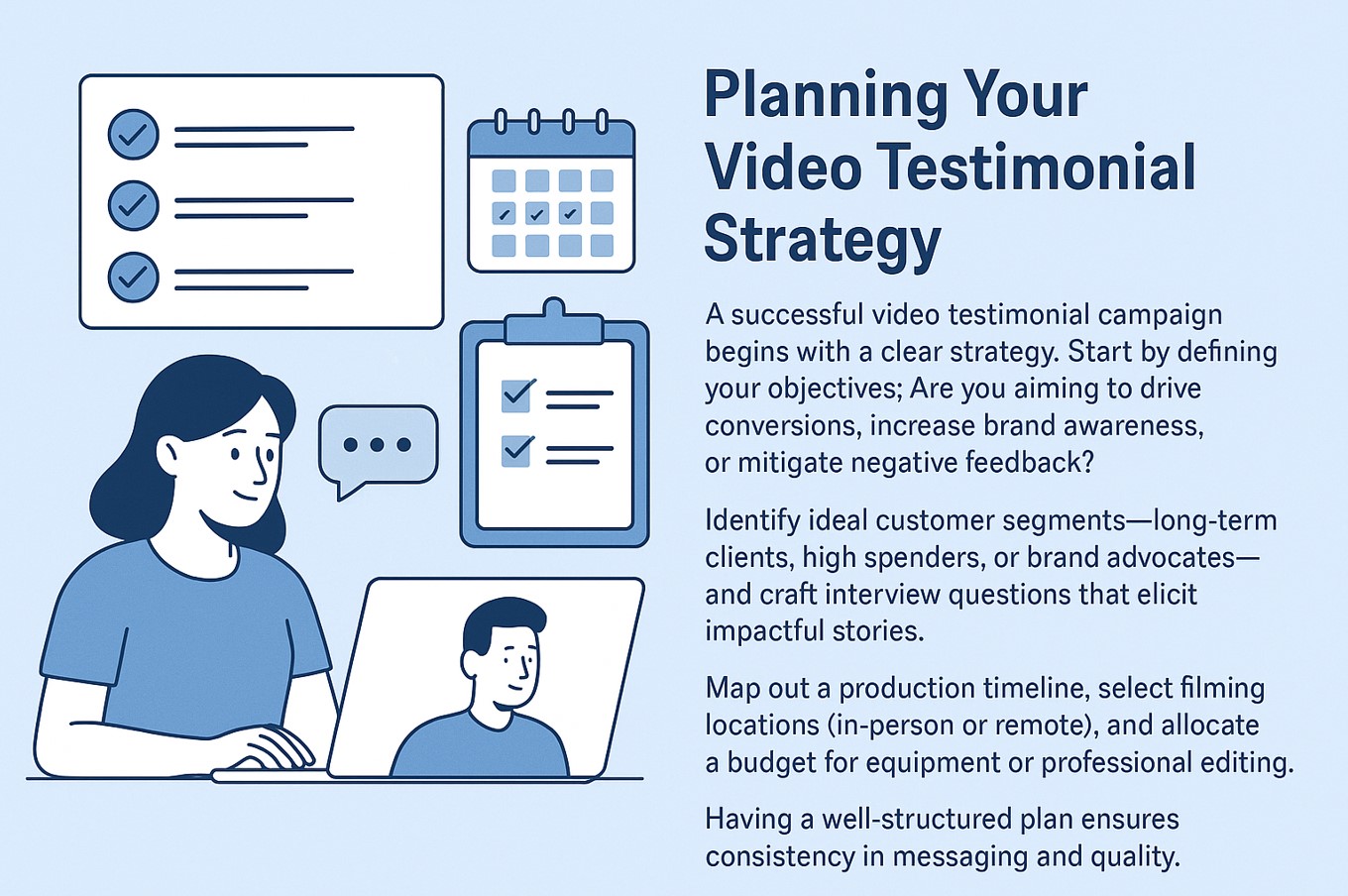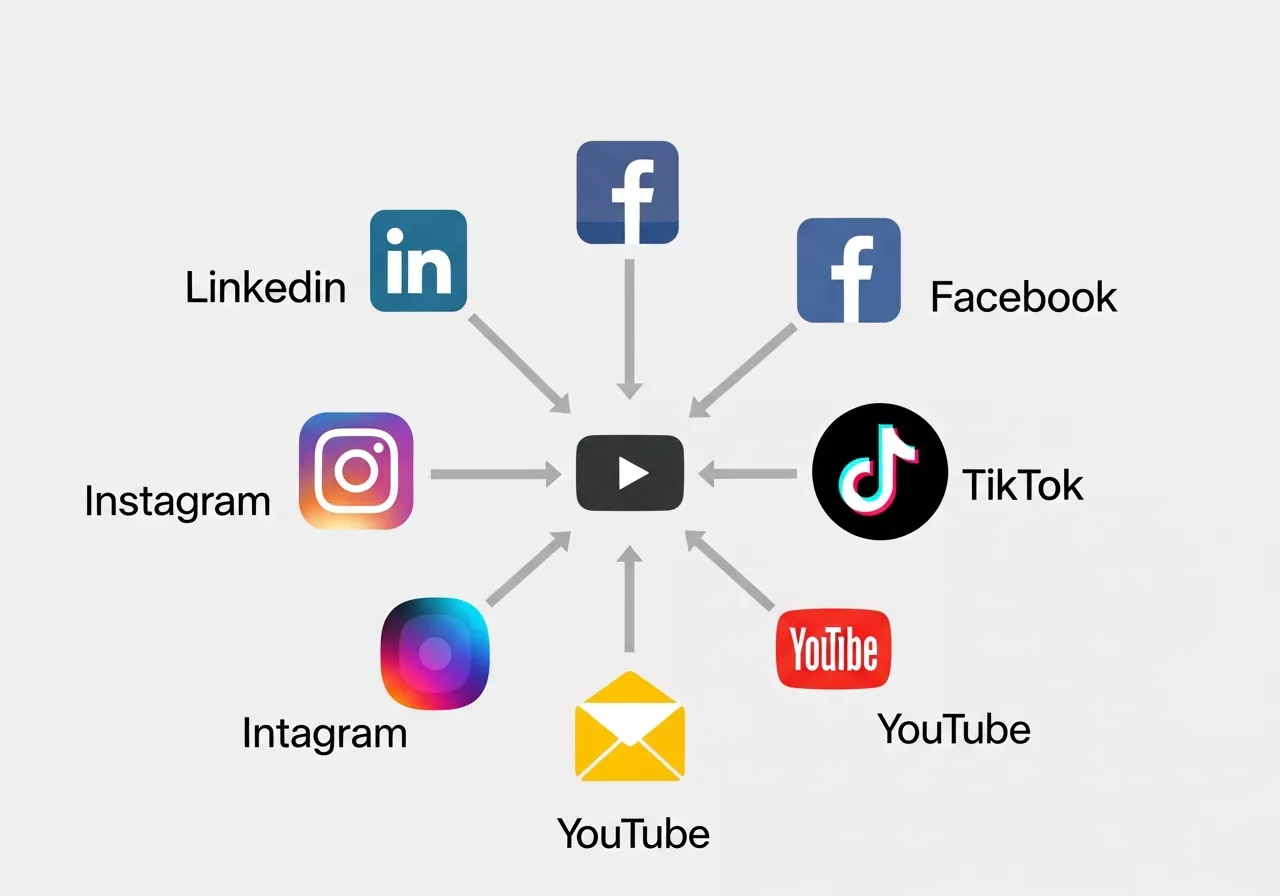Video testimonials offer powerful social proof by showcasing authentic customer experiences. They build trust, boost conversions, and improve SEO. This guide covers the importance of video testimonials, how to plan and produce them, and best practices for distribution and measurement.
In today’s online world, customer feedback plays a pivotal role in shaping brand perceptions. While written reviews and star ratings are valuable, video testimonials take social proof to a whole new level. They capture authentic emotions, real experiences, and detailed insights that text alone can’t convey.
Video testimonials allow potential customers to see and hear from real people, building trust and credibility in ways static reviews can’t match. Studies show that viewers are 50% more likely to make a purchase after watching a video testimonial, underscoring the power of this format.
For brands focused on strengthening their online reputation, incorporating video testimonials into your strategy can significantly enhance trust, boost SEO, and foster stronger customer connections. This guide will walk you through why video testimonials matter, how to plan and produce them, and best practices for distribution and measurement.
Why Video Testimonials Are Crucial for ORM
Video testimonials add a human face to your brand narrative, making potential customers more likely to trust you. According to recent studies, prospects are 50% more likely to purchase after watching a video testimonial. This format demonstrates real experiences, highlights authentic emotions, and reduces skepticism. Search engines and social platforms prioritize rich media, so embedding video testimonials on your site and social channels not only improves user engagement but also boosts your SEO, further reinforcing a positive reputation online.
Planning Your Video Testimonial Strategy

A successful video testimonial campaign begins with a clear strategy. Start by defining your objectives: Are you aiming to drive conversions, increase brand awareness, or mitigate negative feedback? Identify ideal customer segments—long-term clients, high spenders, or brand advocates—and craft interview questions that elicit impactful stories. Map out a production timeline, select filming locations (in-person or remote), and allocate a budget for equipment or professional editing. Having a well-structured plan ensures consistency in messaging and quality.
Collecting Authentic Customer Stories
Authenticity is the cornerstone of effective video testimonials. Reach out to customers who have expressed enthusiasm for your product or service. Provide them with question prompts, but encourage unscripted responses to preserve genuineness. Ask about specific challenges they faced, how your solution helped, and the tangible results they experienced. Ensure interviewees feel comfortable by conducting a brief pre-interview call—this builds rapport and helps them articulate their story naturally, resulting in more compelling footage.
Producing High-Quality Videos on a Budget
High production value doesn’t always require a Hollywood budget. Modern smartphones can capture crisp video with proper lighting and stabilization. Invest in a portable LED light kit and an affordable lapel microphone to enhance audio clarity. Use simplistic, branded backdrops or well-lit office spaces for a professional look. If in-house editing isn’t feasible, consider user-friendly tools like iMovie or DaVinci Resolve. Whichever route you choose, maintain consistent branding—logo placement, color schemes, and lower-thirds—to reinforce brand recognition.
Optimizing Video Testimonials for SEO

To maximize the discoverability of your video testimonials, it’s crucial to optimize them for search engines. Video content is highly favored by search engines and social platforms, so the more effectively you optimize, the more likely it is your testimonials will appear in relevant search results, driving more traffic and improving your online reputation. Here are key steps and best practices to ensure your video testimonials get the attention they deserve:
- Keyword-Rich Titles and Descriptions
Begin with keyword-focused titles and descriptions that accurately describe the content of the testimonial. Use keywords like “customer success story,” “product review,” or “testimonial” along with your brand name and specific product/service terms. This helps search engines understand the content of your video and rank it accordingly. - Host Videos on Multiple Platforms
To increase visibility, host your videos on both your website and popular video platforms like YouTube or Vimeo. These platforms are search engine optimized themselves and can drive more traffic to your site. Additionally, embedding videos on high-traffic pages of your website can further improve SEO. - Use Structured Data (Schema Markup)
Structured data, such as schema.org VideoObject, helps search engines understand your video content. This markup provides specific information about the video, like its duration, description, and thumbnail, allowing search engines to better index and display the video in relevant search results. - Create an HTML Video Sitemap
A video-specific sitemap helps search engines easily find and index video content on your website. This ensures that search engines can properly crawl the video and show it in search results. Make sure your sitemap includes essential metadata such as the video title, description, and URL. - Transcribe and Caption Your Videos
Providing a transcription of your video helps improve both accessibility and SEO. Not only does it allow search engines to crawl the text, but it also benefits users who may have hearing impairments. You can also include closed captions or subtitles directly on the video to further enhance user experience. - Optimize Metadata and Tags
Ensure you optimize all metadata associated with your video (title, description, tags, etc.) using relevant keywords. Proper tags make it easier for search engines and users to find your video when they search for specific terms.
SEO Checklist for Video Testimonials
| SEO Strategy | Best Practices | Impact |
|---|---|---|
| Keyword-Rich Titles | Use relevant keywords like “customer success story,” “product review,” and include your brand name. | Increases video discoverability and rankings. |
| Keyword-Rich Descriptions | Write detailed descriptions with primary and secondary keywords, including benefits, features, and customer experiences. | Enhances SEO and provides context for search engines. |
| Host on Multiple Platforms | Host videos on YouTube, Vimeo, and your website. Cross-link them to increase visibility. | Expands reach and improves SEO rankings. |
| Structured Data Markup | Implement schema.org VideoObject to provide search engines with video metadata like duration, description, and thumbnail. | Helps search engines index and display videos effectively. |
| Transcribe and Caption | Include a transcript and captions/subtitles to make the video accessible and crawlable. | Improves SEO and accessibility for all users. |
| Video Sitemap | Create and submit a video sitemap for your website to help search engines crawl and index your videos. | Ensures proper video indexing by search engines. |
Additional SEO Tips:
-
Optimize Thumbnails: Your video’s thumbnail is the first impression viewers get. Use an eye-catching and relevant image with text overlay to increase clicks.
-
Encourage Engagement: Ask viewers to leave comments or share the video. Engagement metrics like comments, shares, and likes can improve rankings.
-
Embed Videos on High-Traffic Pages: Placing your video on product pages, blog posts, and other highly trafficked areas of your site can increase its visibility and boost SEO.
By implementing these strategies, you can ensure your video testimonials not only engage viewers but also help drive traffic to your website, improve your SEO rankings, and ultimately contribute to building a positive online reputation.
Distributing Video Testimonials Across Channels

A multi-channel distribution strategy ensures your video testimonials reach your target audience wherever they are. Embed them on high-traffic pages—homepage, product pages, and dedicated testimonial pages. Share short clips on social media channels like LinkedIn, Facebook, Instagram, and TikTok, tailoring the length and format to each platform’s best practices. Include videos in email marketing campaigns, newsletters, and case study downloads to boost click-through rates and reinforce your brand’s credibility at key touchpoints in the buyer’s journey.
Measuring Success: Analytics and Feedback
Tracking performance metrics is essential to refining your video testimonial strategy. On your website, monitor engagement metrics like play rate, watch time, and conversion rate lifts on pages featuring testimonials. For hosted videos, use platform analytics to gauge view counts, audience retention, and click-through rates. Solicit viewer feedback through surveys or comment sections to understand sentiment. Use A/B testing—comparing pages with and without videos—to quantify impact on leads, time on page, and sales attribution, enabling data-driven optimization.
Ensuring Compliance and Permissions
Legal and ethical considerations are vital when sharing customer stories. Always obtain signed release forms outlining how you will use the footage—website, social media, ads, and press kits. Respect privacy by redacting sensitive data and offering interviewees the option to review and approve final edits. If minors are involved, secure parental consent according to local regulations. Clear communication around usage rights not only protects your brand legally but also instills participant confidence in your integrity.
Best Practices to Maintain Credibility
To preserve trust, avoid overproducing or scripting testimonials. Over-editing can strip authenticity and raise suspicion. Instead, focus on storytelling: show a mix of spontaneous remarks, emotional reactions, and real product shots. Rotate new testimonials regularly to reflect diverse customer experiences and keep content fresh. Address potential objections head-on—ask customers about initial doubts and how they were overcome. Honest narratives resonate deeply and reinforce an image of transparency and reliability.
Leveraging Video Testimonials for Customer Retention

Video testimonials not only help acquire new customers but can also play a significant role in retaining your existing client base. By showcasing the success stories of loyal customers, you strengthen your relationship with them and reinforce the value of your product or service. Here’s how you can leverage video testimonials for customer retention:
- Build Loyalty: Highlighting your existing customers’ success stories in video form demonstrates appreciation and acknowledgment. It encourages repeat business and fosters long-term relationships.
- Showcase Post-Purchase Value: Instead of focusing only on initial sales, feature customers sharing the lasting impact your product has had on their lives or businesses. This helps reinforce the idea that your brand is a long-term partner, not just a one-time transaction.
- Cross-Sell or Upsell: Videos that emphasize how your customers are using your product in innovative or extended ways can inspire existing users to explore other features, products, or services.
Table Suggestion: Customer Retention vs. Acquisition Strategies with Testimonials
| Strategy | Purpose | Example | Impact on Retention |
|---|---|---|---|
| Feature Loyal Clients | Strengthen brand connection | Video of a client’s success | High |
| Showcase Long-Term Benefits | Highlight sustained value | Customer using product over a year | Moderate |
| Cross-Sell with Testimonials | Introduce new products to existing customers | Video testimonial on product upgrades | High |
How to Handle Negative Testimonials
While positive testimonials can boost your brand, negative feedback, if handled properly, can also work to your advantage. Addressing negative testimonials through video can help showcase your brand’s transparency, empathy, and commitment to improvement. Here’s how to handle negative feedback:
- Acknowledge and Apologize: Acknowledge the issue openly, and if possible, provide a sincere apology. Customers appreciate it when brands take ownership of mistakes.
- Offer Solutions: Feature customers who had negative experiences but saw your efforts to improve the situation. This could be a follow-up on how your company fixed a product issue, made a change based on feedback, or helped the customer in a new way.
- Don’t Overlook Criticism: Instead of deleting or ignoring negative comments, address them constructively in your video testimonials. Showing that you actively listen to feedback will improve customer trust.
- Invite Feedback: Encourage more constructive feedback and make it clear that all opinions matter. Let customers know you value their insights and are continuously striving to improve.
Table Suggestion: Handling Negative Testimonials
| Negative Feedback Type | Response Approach | Example Video | Result |
|---|---|---|---|
| Product Issue | Apology and Solution | Video showing product improvements | Builds trust |
| Service Delay | Acknowledge and Offer Compensation | Video of service recovery and satisfaction guarantee | Demonstrates accountability |
| Customer Misunderstanding | Clarify the Situation | Video where the customer explains their side, followed by a resolution | Reinforces customer care |
Incorporating Video Testimonials in Paid Campaigns
Paid advertising is an excellent opportunity to amplify your video testimonials, particularly when you want to target specific audiences or increase your reach. Including customer stories in your ads makes your campaigns more relatable and engaging. Here’s how to make the most out of video testimonials in paid campaigns:
- Targeted Ads: Use customer videos to specifically target ads to segments that align with the testimonial’s message. For instance, a video of a client from the healthcare industry can be used in campaigns targeting other healthcare professionals.
- Social Proof in Ads: Social proof is a powerful tool in advertising. When you feature customer testimonials in your paid ads, it serves as validation and reassurance for potential buyers, increasing ad effectiveness.
- Create Storytelling Ads: People love stories. Transform your customer testimonials into engaging mini-stories for ads. For example, turn the process of a customer’s problem, the solution your product provided, and the final outcome into an ad narrative.
- Video Retargeting: If someone has already shown interest in your product but hasn’t converted, showing them a testimonial video can build trust and help move them further down the funnel.
Table Suggestion: Types of Paid Campaigns for Video Testimonials
| Paid Campaign Type | Target Audience | Benefits | Example Use Case |
|---|---|---|---|
| Facebook Ads | Broad, segmented | Builds social proof and credibility | New product launch |
| LinkedIn Sponsored Content | B2B professionals | Increases trust and leads in niche markets | Service-focused testimonial |
| YouTube Video Ads | General audience | High engagement and brand awareness | Success stories from clients |
| Retargeting Campaigns | Previous website visitors | Boosts conversions by reinforcing trust | Abandoned cart recovery |
Conclusion and Next Steps
Video testimonials are a powerful asset in any online reputation management toolkit. By planning strategically, producing authentic and optimized content, and distributing it across multiple channels, you can build trust, elevate brand perception, and drive tangible business results. Start small—identify your top advocates, gather your first few stories, and measure the impact. As positive feedback accumulates, integrate video testimonials into your broader marketing and ORM strategy. Embrace these genuine customer narratives to strengthen your online reputation and set your brand apart in a crowded digital world.
FAQ: Video Testimonials
1. What if my customers don’t want to participate in video testimonials?
-
Answer: It’s natural for some customers to be hesitant about appearing on video. To make them more comfortable, you can offer incentives like discounts or freebies. Make it clear that the process is simple and stress-free, and assure them that their personal information will remain confidential. You can also give them the option to approve the final video before it’s published, which may help ease any concerns. Alternatively, if a video isn’t feasible, consider audio or written testimonials.
2. How long should a video testimonial be?
-
Answer: A video testimonial should ideally be between 1-3 minutes. Anything longer can risk losing the viewer’s attention, especially if it’s not highly engaging. Focus on keeping the content concise and impactful—highlighting the customer’s problem, the solution your product provided, and the results they’ve experienced.
3. Can I use video testimonials in paid ads?
-
Answer: Absolutely! Video testimonials are an excellent form of social proof, making them highly effective for paid ads. You can create compelling ads that showcase real customer stories, driving higher engagement and conversions. These types of ads work well on platforms like Facebook, Instagram, LinkedIn, and YouTube. Just make sure the video is optimized for the specific platform’s format and audience.
4. How do I make sure video testimonials don’t come off as too scripted or fake?
-
Answer: Authenticity is key! While it’s helpful to guide customers with a few open-ended questions, avoid scripting their responses. Let them speak naturally about their experiences. Encourage them to share genuine emotions, challenges, and specific results they’ve seen. The more real and spontaneous their responses, the more relatable and credible the testimonial will feel to viewers.
5. Should I be worried about negative feedback in video testimonials?
-
Answer: Not at all! Negative feedback, when handled properly, can actually help build trust. If a customer has a concern or issue, addressing it openly in a video shows transparency and your commitment to improvement. Make sure to respond constructively, show how you’ve resolved the issue, or explain the steps you’re taking to prevent it in the future. This approach builds credibility and shows potential customers that you value feedback.
6. Can I repurpose video testimonials for other marketing materials?
-
Answer: Yes! Video testimonials can be repurposed across various marketing channels and formats. You can use short clips for social media posts, full-length versions on landing pages, in email marketing campaigns, or as part of case studies. Additionally, you can even create highlight reels that compile several testimonials into a single powerful video for presentations, trade shows, or webinars.
7. How do I ensure my video testimonials are SEO-friendly?
-
Answer: To improve the SEO of your video testimonials, make sure to:
-
Use descriptive, keyword-rich titles that reflect what the video is about.
-
Add captions and transcriptions to make the content more accessible and searchable.
-
Host the video on multiple platforms (YouTube, Vimeo, your website) and embed it on high-traffic pages.
-
Optimize metadata (like descriptions and tags) with relevant keywords.
-
Use structured data (schema.org VideoObject) to help search engines understand the content.
-
8. What if I don’t have a big budget for video production?
-
Answer: High-quality video doesn’t always require a Hollywood budget. Modern smartphones can record excellent video if you use good lighting and a tripod for stability. Invest in a lapel mic for clear audio and consider affordable video editing tools like iMovie or DaVinci Resolve. Focus on authenticity over production value—people connect with genuine, real experiences more than polished, overproduced content.
9. How can I encourage customers to leave video testimonials?
-
Answer: To encourage customers to share their stories on video, make the process as easy and seamless as possible. Provide them with clear instructions and a few guiding questions to help them start. You can also offer incentives like discounts, gift cards, or exclusive content as a thank-you for participating. Lastly, remind them that their testimonial could help others make informed decisions, reinforcing the value of their contribution.
10. Can video testimonials really help improve my online reputation?
-
Answer: Yes, video testimonials are one of the most powerful tools for Online Reputation Management (ORM). They provide authentic social proof, showcasing real customers and their genuine experiences. This helps reduce skepticism, build trust with prospects, and differentiate your brand in a crowded market. Plus, video content is more engaging and shareable, which can boost your visibility and SEO efforts.
Learn more about: Why Reputation Management Should Be Part of Your Strategy





